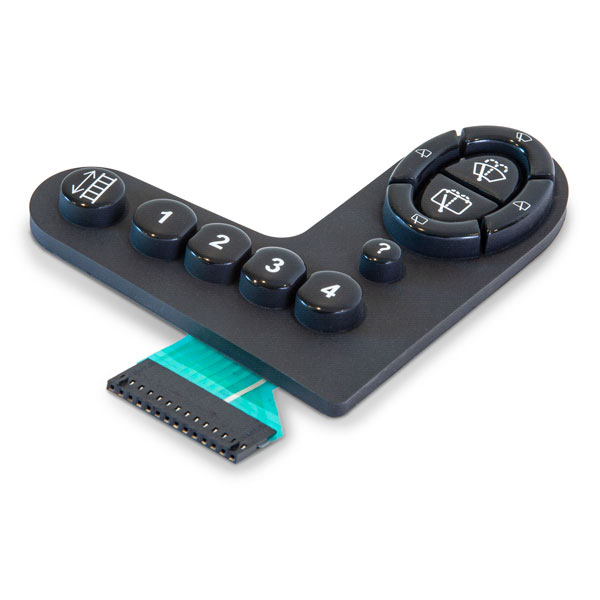Why Membrane Switches are Ideal for Durability and Performance
Why Membrane Switches are Ideal for Durability and Performance
Blog Article
Comprehending Membrane Changes: The Trick to Resilient and Reliable Controls

What Are Membrane Layer Switches?
Membrane switches are an advanced option in the world of interface modern technology, combining functionality and style effortlessly. These gadgets work as a user interface in between customers and digital systems, incorporating numerous components right into a compact format. Normally created from adaptable, slim layers of products, membrane layer buttons are made to reply to touch, making it possible for customers to connect with equipment and digital tools properly.
The primary components of a membrane layer button consist of a published circuit layer, visuals overlay, and a spacer layer that stops unintentional activation. The visuals overlay can be personalized to show brand identity or customer choices, improving aesthetics while ensuring use. Membrane layer switches are typically utilized in various applications, consisting of medical devices, customer electronic devices, and industrial equipment, owing to their durability and resistance to ecological aspects such as wetness and dirt.
Among the essential advantages of membrane layer switches is their capacity to stand up to deterioration, making them ideal for high-traffic settings. Furthermore, they are lightweight and call for very little room, permitting innovative layouts in product development. Generally, membrane switches over represent a effective and practical option for modern digital interfaces, weding innovation with user-centric style concepts.
How Membrane Layer Switches Job
The procedure of membrane layer switches hinges on a straightforward yet effective system that converts user input into electronic signals. When a customer presses the button, the top layer deforms, allowing a conductive aspect in the circuit layer to make call with an equivalent conductive pad on the bottom of the graphic overlay.
The design of membrane switches can vary, however they often incorporate domes or tactile aspects to supply responses to the customer, boosting the total experience - membrane switch. The materials used in membrane switches, such as polyester or polycarbonate, contribute to their sturdiness and resistance to ecological aspects, consisting of dampness and dirt. In addition, the published circuits are typically encapsulated, which protects them from wear and tear over time.
Benefits of Membrane Layer Buttons

In addition, membrane layer buttons are recognized for their resilience. Built from robust materials, they are resistant to dust, wetness, and physical wear, which substantially expands their life-span contrasted to typical mechanical buttons. This durability makes them particularly suitable for high-traffic environments and applications requiring longevity.
Another substantial advantage is the convenience of cleansing and upkeep. The smooth surface of membrane switches reduces dust accumulation and is frequently invulnerable to spills, making them suitable for setups that need frequent sanitization.
Moreover, membrane switches supply a structured profile, resulting in a thinner design that can be incorporated right into different devices without including mass. This function not only boosts the continue reading this visual charm but additionally adds to a much more ergonomic product layout.
Applications of Membrane Layer Switches
Easy to use and versatile, membrane layer switches find applications throughout a large range of industries, consisting of medical tools, consumer electronics, and commercial equipment. In the clinical field, these buttons are important to devices such as analysis devices, patient surveillance systems, and infusion pumps, where integrity and simplicity of cleansing are important. Their ability to withstand harsh atmospheres and keep performance makes them excellent for such applications.

In consumer electronics, membrane layer buttons are utilized in items like microwaves, cleaning devices, and remotes - membrane switch. Their sleek style permits intuitive individual interfaces, boosting the total user experience while supplying durability and resistance to use and tear
Commercial equipment likewise takes advantage of membrane layer buttons, particularly in control panels for machinery and automation systems. These switches use defense against dust and moisture, making sure regular efficiency in challenging environments. Their customizable features enable makers to customize them to details functional needs, enhancing efficiency and performance.
Selecting the Right Membrane Layer Change
When choosing a membrane switch, it is important to think about different elements that influence performance and viability for details applications. The key factors to consider include environmental problems, responsive comments, toughness, and style specifications.
First, assess the operating environment; buttons subjected to moisture, chemicals, or severe temperature levels need particular products to make certain durability and functionality. Next, review the requirement for tactile responses. Depending upon user communication, some applications might benefit from find out here now a responsive action to confirm activation, while others might like a non-tactile design for visual factors.
Resilience is investigate this site an additional important element; membrane buttons ought to be created to hold up against frequent usage, influences, and abrasion. Guarantee the chosen switch can withstand the expected lifecycle, specifically in high-usage situations.

Final Thought
Finally, membrane layer changes serve as crucial components in the style of trusted and resilient control systems across numerous sectors. Their compact style, combined with robust building and customizable features, enhances customer interaction while making sure long life sought after settings. The flexibility of membrane changes enables for customized solutions that satisfy particular functional requirements, strengthening their importance in contemporary technology. As markets remain to develop, the value of integrating reliable membrane layer button services can not be overemphasized.
Membrane layer changes represent a vital aspect of modern-day interface design, blending functionality with resilience in various applications.Membrane layer buttons are an advanced option in the realm of individual interface modern technology, combining performance and layout seamlessly. Generally created from versatile, thin layers of materials, membrane layer buttons are created to respond to touch, making it possible for individuals to engage with equipment and digital gadgets successfully.
The design of membrane buttons can vary, yet they commonly integrate domes or tactile aspects to give comments to the user, enhancing the total experience.In conclusion, membrane layer switches over serve as vital elements in the layout of durable and trustworthy control systems across various sectors.
Report this page